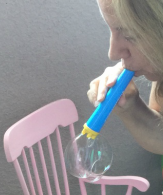 When my kids were little, most children attended preschool, but a trend to supplement the preschool experience had begun. With limited funds, my children were home with me for long stretches of time. No t-ball for tots or music for munchkins. My kids and I played together and with their dad, when we were all home together. We were not super-parents. Although my husband amassed a huge collection of mismatched mechanical parts and gizmos, the often-referred-to “cockpit” never manifested. He did, however, manage to build a substantial sandbox in the backyard for the kids.
When my kids were little, most children attended preschool, but a trend to supplement the preschool experience had begun. With limited funds, my children were home with me for long stretches of time. No t-ball for tots or music for munchkins. My kids and I played together and with their dad, when we were all home together. We were not super-parents. Although my husband amassed a huge collection of mismatched mechanical parts and gizmos, the often-referred-to “cockpit” never manifested. He did, however, manage to build a substantial sandbox in the backyard for the kids.
I’m beginning to think the tradeoff was a good thing. Although a cockpit sounds very exotic and a big project with dad might have been fun, looking back on the proposed vehicle I wonder, “How many times can one be an astronaut or a pilot?” On the other hand, the kids and their friends played for hours each day in the roughly hewn, 8×8 wooden frame filled with sand, and on many occasions, in messy ecstasy with water and mud as well.
As infants, my kids had the run of the kitchen; Martha Stewart would be horrified to know that cooking utensils and paraphernalia were divided into two categories: breakable and unbreakable. The kids played unfettered while I cooked until at some point in their growth they wanted to cook, too. I had no plan; my years as a teacher did not tempt me to create “learning opportunities.” I just watched them to see what they needed. And what they needed was stuff. Lots of stuff; “loose parts”—and time to explore them!
Many years later, on a beautiful summer day at the end of the school year, I visited Bing School at Stanford University and discovered a new-old theory: the theory of “loose parts.” Sarah Wright, a teacher at the school, shared the concept in the school newsletter: “…creativity is… proportionate to the variables.” Thank you, Simon Nicholson, architect, originator of this idea, for filling in a space in my learning!
Paradoxes often reveal the truth about concepts. One grows older yet is young at heart. Energy and creativity spark intellectual growth, yet it is the pauses that allow us to connect with the profound. An active and thoughtful teacher creates a learning environment in which students learn successfully; yet children actively create their own learning from the inside out guided by their intrinsic curiosity. An inspired teacher is able to see the standards hiding in a block of clay, just as Michelangelo saw David in the marble. The paradox: the more the teacher prepares in expectation of the child’s actions, the more “loose parts,” available to the child, the better the child is able to act upon those parts in new and creative ways to increase the effectiveness of his/her learning.
Fads like scripted math and reading programs compete in the marketplace assuring educators uniform successes if teachers dance the same dance, classroom by classroom. We strive for “no child” to be left behind, and “race to the top”, but have we stopped to look where we are going?
In the today’s world, learning theories and research document contradictions in professional practice. We all know that children learn best when teachers instruct and assess the impact of their lessons; yet somehow we have lost touch with the idea that the child must be a participant in the creation of lesson and assessment.
Kids in classrooms need loose parts, guided by adults who step in with a question or to model usefulness, to take learning to the next step. Teachers armed with learning theories do best when guided by their own inner child, seeing both the trajectory of the learning process and the necessity for flexibility and creativity.
